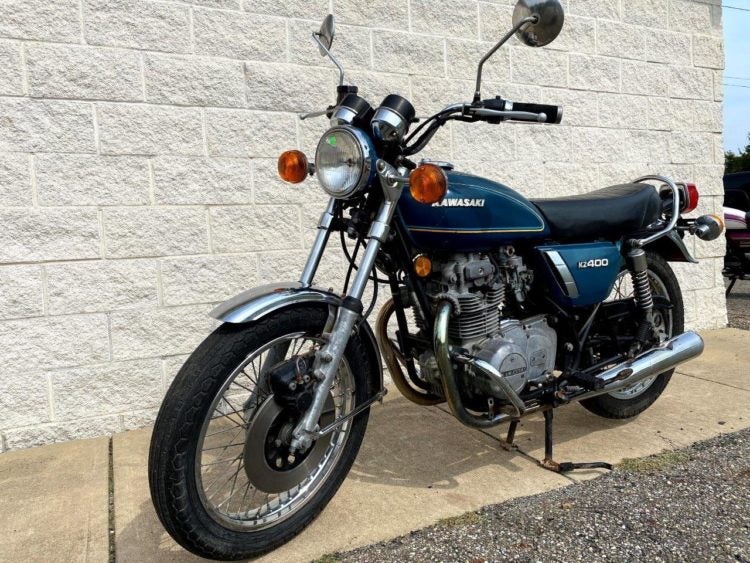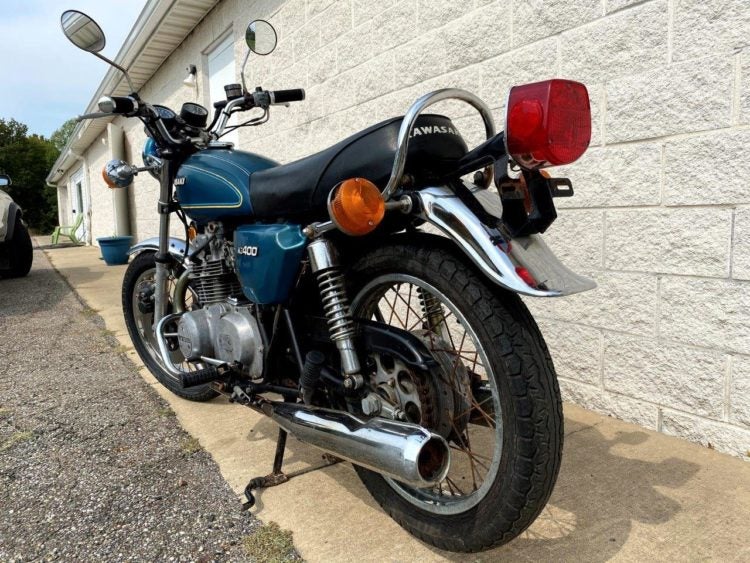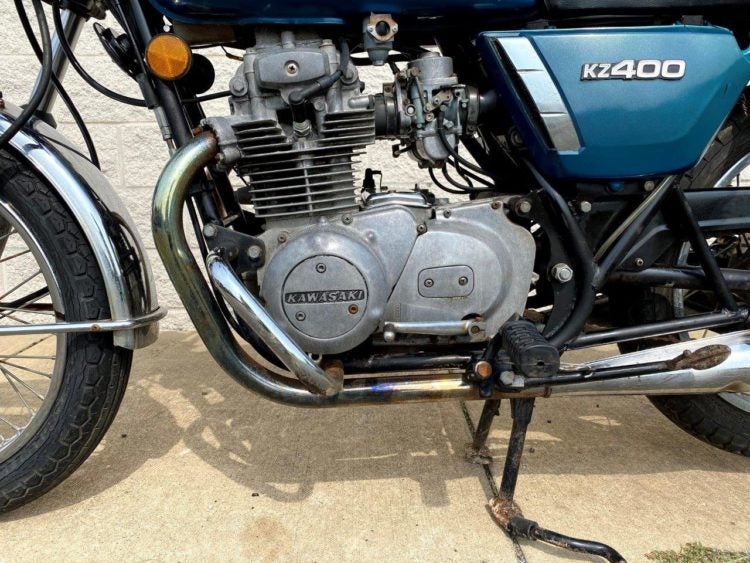These days, everyone’s building a lightweight or middleweight parallel twin motorcycle. Honda has the 500 series, Kawasaki has its 300/400 series, even KTM is developing a new 490cc parallel twin line.
Listening to motojournos talk, you’ll hear them say these new motorcycles are “unexciting.” Well, maybe if you’re used to being jetted about the world to fly Ohlins-equipped hyperbikes, yeah. But to Joe Newbie, a 400 parallel twin has plenty of jam. For a commuter, they’re more than enough for the job. For a budget-strapped adventurer, they’ve got enough power to get across a continent at highway speeds, if needed. That’s why, despite all the changing trends in the motorcycle industry, manufacturers have been building bikes like this since the late 1960s. The silly-fast Z1 might have been Kawasaki’s flagship in the early 1970s, but the KZ400 was the bike that many riders could actually afford. This 1975 model, for sale in the UK, is a good example of the machines that really powered the great UJM revolution.

Fast enough to cross the continent, cheap enough to serve as affordable transport. It’s a formula that still works!
Mass-market lightweight
When it debuted, the KZ400 was late to the game. Kawasaki hadn’t really made anything to challenge Honda’s CB350, and that was proving to be a big mistake.
To understand the Universal Japanese Motorcycle, you need to understand the CB350’s success. The CB750 gets all the press, and Kawasaki built the Z1 900 to challenge that machine. However, the CB350, a low-priced parallel twin, sold like mad in the early 1970s. Not everyone needed a (gasp!) “superbike” like the 750, but everyone needed reliable transportation, and the 350 was getting the job done. Honda sold more than 250,000 of them between 1968 and 1973. The public wanted sensible lightweight motorcycles, and in 1974, Kawasaki introduced the KZ400 to meet that demand.
Kawasaki was no stranger to parallel twin engines. It built its reputation in western markets with the two-stroke A1 Samurai 250 twin, and the W650 four-stroke parallel twin (which shared a lot of DNA with the classic British parallel twin design). The four-stroke 400 was a new direction, though, and distinctly Japanese.

Tut tut! That trim is looking a tad rotten.
The 400 had a 360-degree crank, like many British twins, and the then-popular Yamaha XS650. This resulted in very usable power delivery, but also a lot of rattling, as the engine was basically two thumpers slammed into a single engine case. Unlike the lumpy Brits and the Yamahammer, the KZ400 utilized dual counterbalancers to cut out vibration. This bike might not have had four-cylinder power, but it was as smooth like a four-cylinder.
Alas, these chain-driven balancers are one of the bike’s weaker points now; once those chains start to come apart, the 400 engine self-destructs.

Classic early ’70s UJM styling. Arguably a better-looking machine than the 440 which came later, although less reliable.
Elsewhere, you had a mechanical ignition system (points, not CDI), dual carburetors, a kickstarter in case the electric start crapped out, wet sump and wet clutch, air cooling and a five-speed gearbox. This is all very standard, un-exotic stuff for the mid-’70s, but it all worked. Of course, dual coilover shocks were standard. Although there were some differences between various models to cut down on cost (some were made with no electric start, for instance), most had a single disc brake up front and a drum brake in rear. The 400 came with a chain drive (the later 440 came with a belt drive on some models). Some markets even got a fully-dressed version, with a Windjammer-style fairing and hard bags, although you rarely see these in North America.
Some of the earliest KZ400s had issues with the top end (oil leaks, and general self-destruction), but as time went on, those problems went away. However, the later 440 introduced around 1980, is generally considered a better engine, with more power and reliability. The engines are similar, and some parts will interchange between certain model years. However, the 440 is much more modern-looking, definitely a machine of the ’80s.

Low mileage, and seller says the tires are original. Best to replace ’em, though, if you ride it,
Long-term trouble
Aside from the chain-driven balancers, the 400 engine’s only real weakness was that it was “built down” from the standards that Japan used for its beefier bikes. Plain main bearings don’t have the same long-term viability as roller bearings, and the 400 had a manually-adjusted camchain tensioner.
For the 1970s, this would have been fine, but as time marched on, these bits caused trouble. It’s not just a Kawasaki thing; Suzuki had similar issues with the GS400 line, and Yamaha’s XS400 series also had its own problems. Honda’s 350 and 360 twins didn’t have the same longevity as the company’s four-cylinder models.
It’s unfortunate, but remember, these were designed from the start to be cheap, usable transport, not all-time classics. Kawasaki marketed these bikes on their affordability, with good fuel economy, and that’s what riders got. If you took care of the machine, you’d get your money’s worth.

Those Kawi twins were reliable for their intended usage and service life, mostly, but they were not intended for true lifetime usage like the fours were.
Overseas option
Although the KZ400 isn’t a classic bike on the same level as Kawi’s four-cylinders, it’s getting hard to find one in good shape. This ’75 model is for sale in the UK, but has a US title. Weird, but also cool. Remember, the KZ400 was the first Japanese motorcycle to be built in a US factory, even predating the American production by Toyota, Honda, etc. Presumably, this KZ was built in Lincoln, Nebraska, where Japanese-design-in-US-factory production all started.
The ad says “Great original condition, even has the original tyres on it. The chrome is in good shape but needs polish, the tank is good and fuel drained from floats did not smell bad, bike has been stood for some time and battery was dead and removed the bike has good compression but does not currently run.” Sounds like the £2,895 asking price might be a bit high then, especially as the chrome is crusty and the pinstriping is wonky. But if you really really want a KZ400, this certainly looks like a mostly unmolested original.
Photos: Car and Classic







